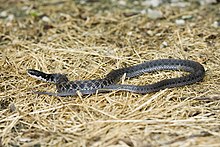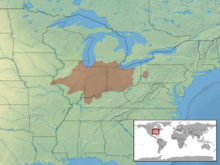Clonophis_kirtlandii
Kirtland's snake
Species of snake
Kirtland's snake (Clonophis kirtlandii) is a threatened or endangered (depending on location) North American species of nonvenomous snake of the subfamily Natricinae, of the family Colubridae.[2] It is the only species in the genus Clonophis.[3]
This article needs additional citations for verification. (March 2020) |
| Kirtland's snake | |
|---|---|
 | |
| Scientific classification | |
| Domain: | Eukaryota |
| Kingdom: | Animalia |
| Phylum: | Chordata |
| Class: | Reptilia |
| Order: | Squamata |
| Suborder: | Serpentes |
| Family: | Colubridae |
| Genus: | Clonophis Cope, 1889 |
| Species: | C. kirtlandii |
| Binomial name | |
| Clonophis kirtlandii (Kennicott, 1856) | |
 | |
| Synonyms | |
| |
The specific name, kirtlandii, is in honor of Dr. Jared Potter Kirtland, an American naturalist of the nineteenth century.[4][5] The snake was first identified by Robert Kennicott in 1855. Kennicott sent a specimen to Spencer Fullerton Baird, the assistant secretary of the Smithsonian Institution, who offered to publish a description of the animal in Kennicott's name. Baird suggested Regina kirtlandii as a scientific name, as Kirtland had been a mentor to Kennicott.[6]
Common names for C. kirtlandii include: Cora Kennicott's snake, Kirtland's red snake, Kirtland's water snake, little red snake, Ohio Valley water snake, and spread head.[7]
Kirtland's snake is small and slender. Adults reach a total length (including tail) of 12-18 inches (30–46 cm). It is grayish brown with a double series of large black spots down the back, and alternating smaller spots running down each side.[8] The ventral scales are brick red with a prominent round black spot at each outer end.[9] It has 19 rows of keeled dorsal scales at midbody, and the anal plate is divided.[10]
Clonophis kirtlandii is currently known to occur in Illinois, Indiana, Kentucky, southern Michigan, northeastern Missouri, Ohio, and northwestern Tennessee.[9][11] Clonophis kirtlandii was historically known from Western Pennsylvania, but it has not been documented in the state since 1966.[11]
The preferred natural habitats of C. kirtlandii are forest, grassland, and wetlands[1] such as swamps and marshes. It is almost always found very close to a water source, even though it is less aquatic than water snakes of the genus Nerodia which share its geographic range.[7] Field studies have shown that populations are found within areas with abundant grass, herbaceous vegetation, and shrubs during the spring season. [12]
The species Clonophis kirtlandii is listed as endangered in Indiana,[13] Michigan, and Pennsylvania.[14] It is listed as threatened in Illinois and Ohio, though current research in Ohio is leaning towards the snake being listed as vulnerable.[citation needed]
Kirtland's snake preys primarily on earthworms, slugs, minnows, salamanders, frogs, and toads.[7] It has also been found to prey on juvenile crayfish, earthworms, slugs, small minnows, and leeches. [11]
When alarmed C. kirtlandii flattens its entire body to a remarkable thinness, and becomes rigid.[15] Kirtland's snake will also coil up into a disc the size of about a quarter in an attempt to hide from potential threats. If this does not succeed, it will then flee instead of fight.[citation needed]
No person on record has ever been bitten by a Kirtland's snake. This species prefers intimidation, hiding, and fleeing rather than any form of fighting.[16]
Kirtland's snake is ovoviviparous. Females give birth in August and September. Brood size varies from 4 to 22. Each newborn is 13–17 cm (5–6¾ in.) in total length and averages 1.4 gm in weight.[7]
- Hammerson, G. A. (2007). "Clonophis kirtlandii ". The IUCN Red List of Threatened Species 2007: e.T63747A12712865. https://dx.doi.org/10.2305/IUCN.UK.2007.RLTS.T63747A12712865.en. Downloaded on 22 March 2020.
- Species Clonophis kirtlandii at The Reptile Database www.reptile-database.org.
- "Clonophis kirtlandii ". ITIS (Integrated Taxonomic Information System). www.itis.gov.
- Beltz, Ellin (2006). Scientific and Common Names of the Reptiles and Amphibians of North America – Explained. ebeltz.net/herps/biogappx.doc#K.
- Beolens, Bo; Michael Watkins; Michael Grayson (2011). The Eponym Dictionary of Reptiles. Baltimore: Johns Hopkins University Press. xiii + 296 pp. ISBN 978-1-4214-0135-5. (Clonophis kirtlandi, p. 142).
- Wright, A.H., and A.A. Wright (1957). Handbook of Snakes of the United States and Canada. Ithaca and London: Comstock. 1,105 pp. (in 2 volumes) (Natrix kirtlandi, pp. 496-499, Figure 146 + Map 40 on p. 491).
- Boulenger, G.A. (1893). Catalogue of the Snakes in the British Museum (Natural History). Volume I., Containing the Families ... Colubridæ Aglyphæ, part. London: Trustees of the British Museum (Natural History). (Taylor and Francis, printers). xiii + 448 pp. + Plates I.- XXVIII. (Ischnognathus kirtlandii, p. 286).
- Conant, R. (1975). A Field Guide to Reptiles and Amphibians of Eastern and Central North America, Second Edition. Boston: Houghton Mifflin. xviii + 429 pp. + Plates 1-48.
ISBN 0-395-19979-4 (hardcover), ISBN 0-395-19977-8 (paperback). (Natrix kirtlandi, p. 151 + Plate 22 + Map 106). - Smith, H.M., and E.D. Brodie Jr. (1982). Reptiles of North America: A Guide to Field Identification. New York: Golden Press. 240 pp. ISBN 0-307-13666-3.
(Clonophis kirtlandi, pp. 156-157). - U.S. Fish and Wildlife Service (2017). Species status assessment report for Kirtland’s snake (Clonophis kirtlandii). 43 pp.
- Life Science Weekly (2020). Exploration of Environmental DNA (eDNA) to Detect Kirtland's Snake
- Indiana Legislative Services Agency (2011), "312 IAC 9-5-4: Endangered species of reptiles and amphibians", Indiana Administrative Code, retrieved 28 Apr 2012.
- Pennsylvania Fish & Boat Commission.
- Schmidt, K.P., and D.D. Davis (1941). Field Book of Snakes of the United States and Canada. New York: G.P. Putnam's Sons. 365 pp. (Natrix kirtlandii, pp. 209-210 + Plate 22, Center, on p. 342).
- "Clonophis kirtlandii - Kirtland's Snake". USA Snakes. 2020-10-22. Retrieved 2020-10-22.
- Behler, J.L., and F.W. King (1979). The Audubon Society Field Guide to North American Reptiles and Amphibians. New York: Alfred A. Knopf. 743 pp. ISBN 0-394-50824-6. ("Clonophis kirtlandi [sic]", p. 596 + Plate 551).
- Conant, R., and W. Bridges (1939). What Snake Is That? A Field Guide to the Snakes of the United States East of the Rocky Mountains. (With 108 drawings by Edmond Malnate). New York and London: D. Appleton-Century Company. Frontispiece map + viii + 163 pp. + Plates A-C, 1-32. (Natrix kirtlandii, p. 95 + Plate 16, figure 47).
- Kennicott, R. (1856). "Description of a new Snake from Illinois". Proc. Acad. Nat. Sci. Philadelphia 8: 95-96. (Regina kirtlandii, new species).
- McCoy, C.J. (1980). Identification Guide to Pennsylvania Snakes. (Design and illustrations by Michael Antonoplos). Pittsburgh Pennsylvania: Carnegie Museum of Natural History. 12 pp. (Clonophis kirtlandi, p. 8).
- Netting, M.G., and Richmond, N.D. (editors) (1970). Pennsylvania Reptiles and Amphibians. (Photographs by Hal H. Harrison). Third Edition, Fifth Printing. Harrisburg, Pennsylvania: Pennsylvania Fish Commission. 24 pp. (Natrix kirtlandii, p. 3).
- Powell, R., R. Conant, and J.T. Collins (2016). Peterson Field Guide to Reptiles and Amphibians of Eastern and Central North America, Fourth Edition. Boston and New York: Houghton Mifflin Harcourt. xiv + 494 pp. ISBN 978-0-544-12997-9. (Clonophis kirtlandii, pp. 410–411+ Plate 40).
- Rossman, D.A. (1963). "Relationships and taxonomic status of the North American natricine snake genera Liodytes, Regina and Clonophis ". Occasional Papers of the Museum of Zoology, Louisiana State University (29): 1–29.
- Stejneger, L., and T. Barbour (1917). A Check List of North American Amphibians and Reptiles. Cambridge, Massachusetts: Harvard University Press. 125 pp. (Natrix kirtlandii, p. 95).
